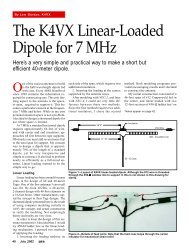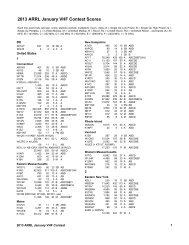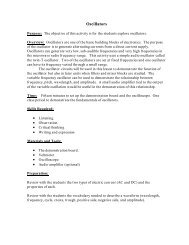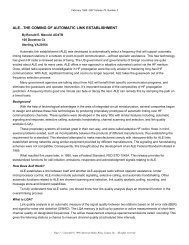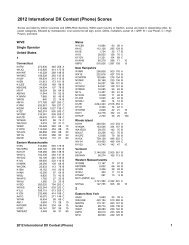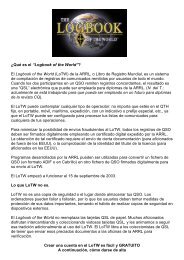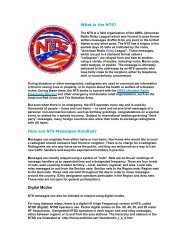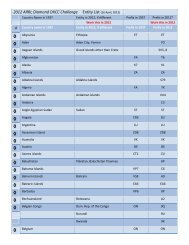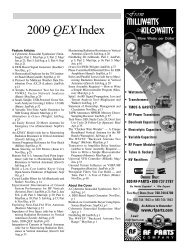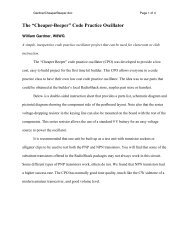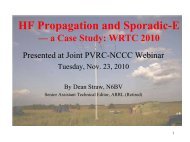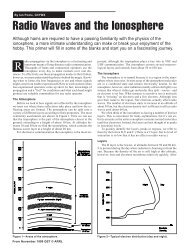A Software Defined Radio for the Masses, Part 4 - ARRL
A Software Defined Radio for the Masses, Part 4 - ARRL
A Software Defined Radio for the Masses, Part 4 - ARRL
Create successful ePaper yourself
Turn your PDF publications into a flip-book with our unique Google optimized e-Paper software.
timing problem. In <strong>the</strong> final circuit, I<br />
chose to use <strong>the</strong> parallel mode.<br />
According to Peter Chadwick’s article<br />
(Note 20), phase-noise dynamic<br />
range is often <strong>the</strong> limiting factor in receivers<br />
instead of IMD dynamic range.<br />
The AD9854 has a residual phase noise<br />
of better than –140 dBc/Hz at a 10-kHz<br />
offset when directly clocked at 300 MHz<br />
and programmed <strong>for</strong> an 80-MHz output.<br />
A very low-jitter clock oscillator is<br />
required so that <strong>the</strong> residual phase<br />
noise is not degraded significantly.<br />
High-speed data communications<br />
technology is <strong>for</strong>tunately driving <strong>the</strong><br />
introduction of high-frequency crystal<br />
oscillators with very low jitter specifications.<br />
For example, Valpey Fisher<br />
makes oscillators specified at less than<br />
1 ps RMS jitter that operate in <strong>the</strong><br />
desired 200-300 MHz range. According<br />
to Analog Devices, 1 ps is on <strong>the</strong> order<br />
of <strong>the</strong> residual jitter of <strong>the</strong> AD9854.<br />
Band-Pass Filters<br />
Theoretically, <strong>the</strong> QSD will work just<br />
fine with low-pass ra<strong>the</strong>r than bandpass<br />
filters. It responds to <strong>the</strong> carrier<br />
frequency and odd harmonics of <strong>the</strong> carrier;<br />
however, very large signals at half<br />
<strong>the</strong> carrier frequency can be heard in<br />
<strong>the</strong> output. For example, my measurements<br />
show that when <strong>the</strong> receiver is<br />
tuned to 7.0 MHz, a signal at 3.5 MHz<br />
is attenuated by 49 dB. The measurements<br />
show that <strong>the</strong> attenuation of <strong>the</strong><br />
second harmonic is 37 dB and <strong>the</strong> third<br />
harmonic is down 9 dB from <strong>the</strong> 7-MHz<br />
reference. While a simple low-pass filter<br />
will suffice in some applications, I<br />
chose to use band-pass filters.<br />
Fig 8 shows <strong>the</strong> six-band filter design<br />
<strong>for</strong> <strong>the</strong> SDR-1000. Notice that only<br />
Fig 5—Output signal-to-noise ratio excluding external<br />
(atmospheric) noise. INA gain is set to 60 dB. Antenna signal level<br />
<strong>for</strong> saturation is –33.7 dBm.<br />
28 Mar/Apr 2003<br />
<strong>the</strong> 2.5-MHz filter has a low-pass characteristic;<br />
<strong>the</strong> rest are band-pass filters.<br />
SDR-1000 Board Layout<br />
For <strong>the</strong> final PC-board layout, I decided<br />
on a 3×4-inch <strong>for</strong>m factor. The<br />
receiver, exciter and DDS are located<br />
on one board. The band-pass filter and<br />
a 1-W driver amplifier are located on<br />
a second board. The third board has a<br />
PC parallel-port interface <strong>for</strong> control,<br />
and power regulators <strong>for</strong> operation<br />
from a 13.8-V dc power source. The<br />
three boards sandwich toge<strong>the</strong>r into<br />
a small 3×4×2-inch module with rearmount<br />
connectors and no interconnection<br />
wiring required. The boards use<br />
primarily surface-mount components,<br />
except <strong>for</strong> <strong>the</strong> band-pass filter, which<br />
uses mostly through-hole components.<br />
Acknowledgments<br />
I would like to thank David Brandon<br />
and Pascal Nelson of Analog Devices<br />
<strong>for</strong> <strong>the</strong>ir answering my questions<br />
about <strong>the</strong> AD9854 DDS. My appreciation<br />
also goes to Mike Pendley,<br />
WA5VTV, <strong>for</strong> his assistance in design<br />
of <strong>the</strong> band-pass filters as well as his<br />
ongoing advice.<br />
Conclusion<br />
This series has presented a practical<br />
approach to high-per<strong>for</strong>mance<br />
SDR development that is intended to<br />
spur broad-scale amateur experimentation.<br />
It is my hope—and that of <strong>the</strong><br />
<strong>ARRL</strong> SDR Working Group—that<br />
many will be encouraged to contribute<br />
to <strong>the</strong> technical art in this fascinating<br />
area. By making <strong>the</strong> SDR-1000<br />
hardware and software available to<br />
<strong>the</strong> amateur community, software ex-<br />
tensions may be easily and quickly<br />
added. Thanks <strong>for</strong> reading.<br />
Notes<br />
1 M. Markus, N3JMM, “Linux, <strong>Software</strong> <strong>Radio</strong><br />
and <strong>the</strong> <strong>Radio</strong> Amateur,” QST, October<br />
2002, pp 33-35.<br />
2 The GNU <strong>Radio</strong> project may be found at<br />
www.gnu.org/software/gnuradio/<br />
gnuradio.html.<br />
3 G. Youngblood, AC5OG, “A <strong>Software</strong> <strong>Defined</strong><br />
<strong>Radio</strong> <strong>for</strong> <strong>the</strong> <strong>Masses</strong>: <strong>Part</strong> 1,” QEX,<br />
Jul/Aug 2002, pp 13-21.<br />
4 G. Youngblood, AC5OG, “A <strong>Software</strong> <strong>Defined</strong><br />
<strong>Radio</strong> <strong>for</strong> <strong>the</strong> <strong>Masses</strong>: <strong>Part</strong> 2,” QEX,<br />
Sep/Oct 2002, pp 10-18.<br />
5 G. Youngblood, AC5OG, “A <strong>Software</strong> <strong>Defined</strong><br />
<strong>Radio</strong> <strong>for</strong> <strong>the</strong> <strong>Masses</strong>: <strong>Part</strong> 3,” QEX,<br />
Nov/Dec 2002, pp 27-36.<br />
6 R. Green, VK6KRG, “The Dirodyne: A New<br />
<strong>Radio</strong> Architecture?” QEX, Jul/Aug 2002,<br />
pp 3-12.<br />
7 D. H. van Graas, “The Fourth Method: Generating<br />
and Detecting SSB Signals,” QEX,<br />
Sep 1990, pp 7-11.<br />
8 D. Tayloe, N7VE, “Letters to <strong>the</strong> Editor,<br />
Notes on ‘Ideal’ Commutating Mixers (Nov/<br />
Dec 1999),” QEX, Mar/Apr 2001, p 61.<br />
9 P. Rice, VK3BHR, “SSB by <strong>the</strong> Fourth<br />
Method?” ironbark.bendigo.latrobe.edu.<br />
au/~rice/ssb/ssb.html.<br />
10 M. Kossor, WA2EBY, “A Digital Commutating<br />
Filter,” QEX, May/Jun 1999, pp 3-8.<br />
11 C. Ping, BA1HAM, “An Improved Switched<br />
Capacitor Filter,” QEX, Sep/Oct 2000,<br />
pp 41-45.<br />
12 P. Anderson, KC1HR, “Letters to <strong>the</strong> Editor,<br />
A Digital Commutating Filter,” QEX,<br />
Jul/Aug 1999, pp 62.<br />
13 D. Weaver, “A Third Method of Generation<br />
of Single-Sideband Signals,” Proceedings<br />
of <strong>the</strong> IRE, Dec 1956.<br />
14 P. Anderson, KC1HR, “A Different Weave<br />
of SSB Exciter,” QEX, Aug 1991, pp 3-9.<br />
15 P. Anderson, KC1HR, “A Different Weave of<br />
SSB Receiver,” QEX, Sep 1993, pp 3-7.<br />
16 C. Puig, KJ6ST, “A Weaver Method SSB<br />
Modulator Using DSP,” QEX, Sep 1993,<br />
pp 8-13.<br />
Fig 6—Output signal-to-noise ratio <strong>for</strong> <strong>the</strong> 10-m band including<br />
external (atmospheric) noise. INA gain is set to<br />
40 dB. Antenna signal level <strong>for</strong> INA saturation is –13.7dBm.



